Table of Contents[Hide][Show]
How to make homemade ghee on the stovetop quickly and easily for a healthy cooking fat that is shelf stable and nourishing.
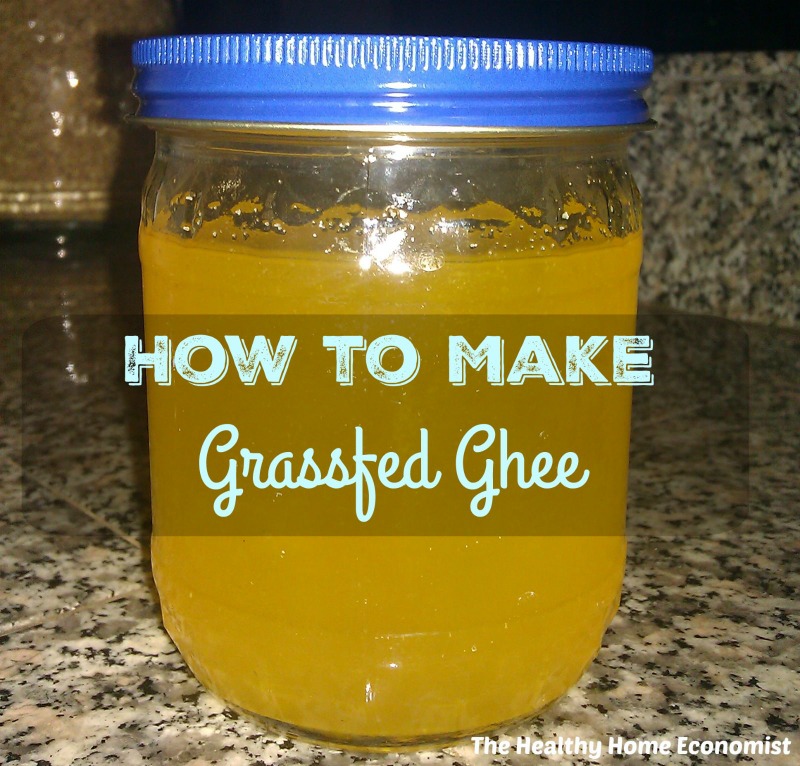
Knowing how to make ghee is simply a must for any Traditional Cook. Clarified butter as it is also known, has been used for thousands of years by Indian cultures. In fact, traces of ghee have been found on fragments of Indian pottery dating as far back as 6500 BC!
When in a liquid state and made from unheated butter, ghee is called butter oil. Dr. Weston A. Price discovered that butter oil and cod liver oil work synergistically to supercharge absorption of Vitamins A, D, and K2 known as the X-factor.
Dr. Price always carried flasks of cod liver oil and butter oil to the bedside of very ill patients. More often than not, he was able to revive them with a few drops of each under the tongue. Using cod liver oil or butter oil separately did not have the same deathbed reviving effects.
Benefits of Ghee over Other Cooking Fats
It is best to know how to make clarified butter oil or ghee yourself rather than buying from the store. Notice the picture above of a jar that I made myself with pastured butter from a local farm. It is so yellow!
Commercial ghee from the store is a pale yellow, indicating lower nutritional value from cows eating grain mix instead of fresh green grass.
Ghee from the store is also ridiculously expensive, so learning to make it yourself is not only a more nutritious way to go, it is very cost-effective.
I make clarified butter oil for about half the cost of what it would be to buy it at the health food store.
Unlike butter, ghee does not need refrigeration and keeps well on the counter or pantry for many months. Keeping a jar in the pantry for a quick veggie saute is very convenient!
Another benefit of ghee is that it is easier to digest as all the milk solids (proteins) have been removed from the butter. Very frequently, even those with a true dairy allergy find that ghee presents no trouble for them.
Another advantage to using clarified butter instead of plain grass-fed butter is that the grassy taste and sometimes cheesy smell of the butter is eliminated.
Therefore, by learning to make clarified butter oil from grass-fed butter, you will find that you now have a healthy fat for cooking that does not displease your family with a cheesy odor. This can sometimes happen with grass-fed butter alone.
Homemade Grass-Fed Ghee
The recipe and video lesson below covers how to make this healthy and indispensable fat for use in your own kitchen.
I also cover how to make clarified butter capsules. This is a convenient way to take butter oil with your daily dose of cod liver oil.
If you are spending money on high vitamin cod liver oil (this is the brand I’ve used since 2015) it is a must to be taking it with clarified butter oil. This supercharges the beneficial effects!
Note that it is not advisable to make ghee from homemade raw butter. The heating process causes a loss of the enzyme and probiotics in this special food.
Prefer to Buy?
If after reviewing the recipe and video demo below you decide to buy instead, I would recommend this vetted source as a premier retailer of quality grass-fed ghee. Plain, cultured, and herb-flavored varieties are all available including a coconut oil/ghee blend.
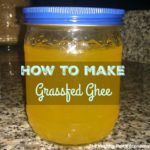
How to Make Ghee
This simple recipe for making ghee can be accomplished on the stovetop in just a few minutes.
Ingredients
- 1 lb butter preferably grassfed and organic
- 1 wide mouthed mason jar quart size
- 1 cheesecloth fine mesh
- 1 funnel
Instructions
-
Place pound of butter in a medium sized pot or stove safe glass bowl. Turn heat on low and allow the butter to gently liquefy.
-
Turn heat to medium-low and gently remove foam that comes to the top of the melted butter with a slotted spoon.
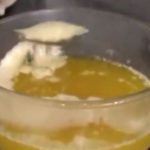
-
After removing the foam, allow the melted butter to simmer on medium-low heat for 5-10 minutes longer to allow all the milk solids to settle out on the bottom of the bowl. You will know when the separation process is complete as the solids will be slightly brown on the bottom and the clarified butter will be completely clear and transparent.
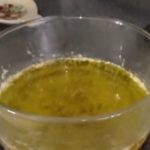
-
Line a funnel placed into the open end of a wide mouthed mason jar with a fine mesh cheesecloth.
-
Pour the clarified butter into the funnel so that it is strained through the cheesecloth as it enters the mason jar.
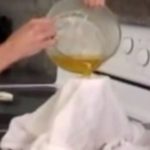
-
Allow the finished ghee to cool in the mason jar. When room temperature, fasten the lid on tightly and store in the pantry as a convenient and incredibly healthy cooking oil for all your kitchen needs.








Thank you, Sarah. We make a lot of ghee and I’ve found it MUCH easier to simply let four pounds of butter simmer for a couple/few hours. The milk solids all fall to the bottom of the pan and no skimming is required. Strain the oil and that’s all. Lightened up my efforts on Ghee Day!
Hi Michelle, what concerns me with not skimming is that the foam (off flavors) would end up in the butter oil. I’m not sure that it would fall to the bottom.
This same thing would happen making stock .. if you don’t skim the foam it ends up on the broth and the broth ends up not tasting as good.
Hi, You used the words low temperature pasteurization. What is its definition? We still have snow on the ground where I live so it will be 6 weeks or so before I can get the spring grass fed milk/butter. You said you use a lot of it. How much is that? I’m wondering how much butter I should have to make a years worth of ghee for a family of 4. I’m still learning lots about traditional cooking and have been making changes since last August. The grass grows between April/May and September where I live. Sounds like the butter in May would be better than that from August. Thanks.
Hi Jean, low temp pasteurization is also known as “vat pasteurization”. Ask you farmer about it and he/she will know what it is and whether they offer grassfed butter of this kind. We use the ghee from 1 lb of grassfed butter about every 2-3 weeks (this is in addition to the butter we use). August butter is also fantastic so no worries if you can’t stock up enough May butter.
I love ghee and I make it myself too. I will definitely share this video on my facebook page..
Victoria, you are very kind! Thank you! 🙂
Hi Sarah,
I just have to tell you how beautiful you look! Wow! Just beautiful!
Blessings!
The best butter that I can find nearby is salted; would that work?
Hi Sara, yes it will work. Some ghee recipes call for a bit of salt to be added to the unsalted butter prior to straining (unsalted is more traditional) but as long as you don’t add any additional, it should be ok.
Hey Sarah,
I am confused about the nutritional properties of butter oil. I was under the impression that heat destroys most of the nutrients in foods, which is why raw milk products are much more nutritionally dense than pasteurized. I guess I’m just wondering what nutrition is left after all the heating of the butter oil? What vitamins resist heat and which break down etc.?
Thank you so much!
-Caitlin
Hi Caitlin, heating such as what happens with pasteurization (particularly high heat pasteurization such as what happens with UHT milk) destroys the enzymes and it is particularly damaging and denaturing for milk proteins. The milk fat, however, is rather stable when heated and not harmed other than enzymes being lost which is why pasteurized butter is still recommended if that is all that a person can afford (although raw butter would certainly be a better choice if this is in the family budget). When you make ghee .. you are removing the fragile milk proteins and leaving only the fat which is still highly nutritious after the process is complete.
Hi Sarah,
I guess I’m confused because you say ghee can be used as a substitute for Green Pastures Butter Oil, which has vit.’s A,D, K etc. in it. But heat destroys these vitamins. Doesn’t the process of making ghee destroy these vitamins? Is there a way to make ghee that leaves the vitamins intact? And do you know how they make the butter oil from Green Pastures? Do they heat it and then add the vitamins back in, or do they process it without heat? Or is it some other component in the butter oil which, when combined with Cod Liver Oil, makes the pair really powerful for the body?
Thanks,
-Caitlin
??
Caitlin, I don’t believe vitamins A, D & K are destroyed by heat as, say, vitamin C is.
As for the Green Pastures process of raw centrifuged butter, there are a couple of mentions above, and you can read about it on their website, http://www.greenpasture.org. See the blog archives on their website for interesting info, such as:
http://www.greenpasture.org/fermented-cod-liver-oil-butter-oil-vitamin-d-vitamin-a/part-2–deeper-discussion–why-fclo-and-high-vitamin-butter-oil/
The http://www.westonaprice.org website is also chock full of great info – just type a word in their search field and see the amazing array of results that you get!
Would just eating butter along with the daily dose of cod liver oil have the same effect as taking clarified butter? We eat a lot of butter, especially with breakfast, which is when we take our cod liver oil, so I’m wondering if we need to add the extra spoonful of clarified butter or is the butter we use on our bread enough (amounts to a good teaspoon or two per person as well).
Hi Miika, if the butter is from a good local source and grassfed, then yes, that would be great. Few people take a spoon of grassfed butter with their cod liver oil, though, which is why butter oil is quite convenient.
I’m so glad Miika asked that question! I was thinking the same thing…. can’t I just take my CLO with a meal that has butter…. Could you please give me a link to where I can find out why FERMENTED CLO is better? I have not purchased any yet. It seems so very expensive. My husband and I both take Norwegian CLO that we get through Swanson Vitamins, and it is nice stuff. Will it not be of benefit to us? Thank you for your lovely blog and videos. You have helped and inspired me a lot.
Wow, for some reason I never realized that butter oil and gee were the same thing. But now I’m slightly confused about two things. Why is the gee I buy in the store a soft solid and the butter oil I get from green pastures a liquid? Also the gee I buy says it does not need to be refrigerated but the butter oil from green pastures says that it should be refrigerated after opening (making it rather difficult to measure and take)?
Hi Emily, ghee (butter oil) goes from a liquid to a solid somewhere around 75F same as coconut oil which is why sometimes you will find it as a liquid but depending on the temp of your house it may go semi-solid in the pantry. Green Pastures butter oil does not need to be refrigerated but perhaps the label says as much for labeling law purposes as some folks would leave in the cupboard for over a year and then it would go bad. But, if you use it up in a few months as we do, then no need to refrigerate.
Ahhhh, you may have answered my question. I made ghee yesterday according to your video and this morning I found it soft solid. It is rather cold in our house. I was thinking that I somehow didn’t make it correctly, but maybe I did? How do I know whether I made it right if it becomes semi-solid? Also, is it typical that you find yourself skimming foam the entire time it’s on the stove top? Just as I would think all the foam was gone, more would appear. I’d appreciate your thoughts on the Sarah! Thanks!
Mine is a semi solid right now in the pantry. It will be a liquid once the warmer weather comes. Just skim as much foam as you can as these are off flavors and you don’t want them staying in the butter oil which is why I don’t use the oven method for making it.
Hi Sarah,
Does your family pay the extra to buy the Green Pastures butter oil since it is raw? Or do you just take the homemade butter oil? Just wondering as I’m trying to decide the best course to take. We’ve been buying the Green Pastures stuff, but it is SO expensive. Do you know if the butter oil Weston Price referred to in his studies was raw or cooked?
Hi Sarah, we do buy Green Pastures butter oil but we need more butter oil than that which is why I also make it.
Oh and Dr. Price centrifuged his own butter oil which is the same process Green Pastures’ uses from what I understand from Dave Wetzel, the owner. Making it at home over the stove or even in the oven if you prefer is an inferior process to centrifuging which retains rawness, but this homemade butter oil is still highly nutritious and very much worth your time and effort to make if you are not currently taking any butter oil in the diet.